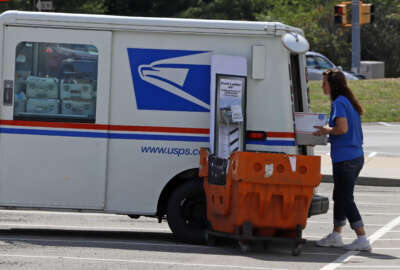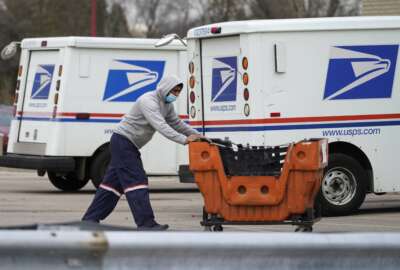

DeJoy, speaking at the American Enterprise Institute on Wednesday, said he plans to consolidate 500 facilities that USPS processes and moves mail through down t...
Postmaster General Louis DeJoy says the Postal Service may need to reduce its employee headcount by 50,000 positions, as the agency looks to consolidate its network of facilities that process mail.
DeJoy, speaking at the American Enterprise Institute on Wednesday, said he plans to consolidate 500 facilities that USPS processes and moves mail through down to about 65 or 75 regional hubs.
DeJoy said he’s “committed to a stable workforce,” and is working with postal unions on this effort, but will easily manage any headcount reduction through normal attrition, which results from employees retiring or leaving the agency.
“Right now, to get to break-even, I think we may need to get 50,000 people out of the organization. But that’s OK, because over [the next 10 years] 200,000 people leave the organization for retirement. So we’re going to be a hiring organization,” DeJoy said. “We need to be good at retention, we need to be good at recruiting people, and we’re doing a lot of different activity around there.”
DeJoy told reporters following the event that the Sort and Delivery Centers that USPS is creating to consolidate operations will be a mix of new construction and renovations to existing plants.
“We’ll take equipment out, we’ll rearrange it into a logical sequence within the plants. We basically do seven different functions — package destinating processing, package originating processing, destinating mail processing — and we will configure them appropriately once we get into the region,” DeJoy said.
Among the facilities that face consolidation, DeJoy said USPS will close 150 annexes — about 40 of which USPS opened to support a surge of packages during the peak holiday season at the end of last year.
“We’re going to shed those, and this is going to take four years or so to really happen,” DeJoy said.
DeJoy said the USPS Sort and Delivery Centers will have enough space, docks and mail processing equipment to operate more efficiently than its current infrastructure. He said USPS will construct new Sort and Delivery Centers in Atlanta, Indianapolis and Charlotte, but will also convert some existing facilities.
“We’re actually opening all our closed plants. We have like 1,000 plants that are just sitting around, and we’re converting and putting a lot of money into it, and making them launch delivery units and package processing operations,” he told reporters.
Meanwhile, a reconciliation deal announced Wednesday evening by Senate Majority Leader Chuck Schumer (D-N.Y.) and Sen. Joe Manchin (D-W.V.) would give USPS $3 billion to purchase electric vehicles and charging infrastructure.
A bill summary describes the $3 billion USPS spending as part of a larger $9 billion investment in “federal procurement of American-made clean technologies to create a stable market for clean products.”
The funding from Congress would give USPS greater purchasing power for an electric fleet, compared to what the agency could afford on its own.
USPS recently announced that it will, for now, only plan to buy the 50,000 next-generation delivery vehicles (NGDVs) it ordered in March, the minimum outlined in its contract with Oshkosh Defense.
The agency, however, now ensures no less than 50% of those custom-built vehicles will be electric vehicles. To replace its aging vehicle fleet more immediately, USPS plans to purchase 34,500 commercial off-the-shelf (COTS) vehicles over a two-year period.
“We’re interested in COTS, we’re always searching for better ways. We’ll evaluate that, but having a special purpose-built vehicle that you have gone through a two-and-a-half, three-year diligence process to design matters,” DeJoy told reporters.
All told, USPS expects 40% of these 84,500 vehicles will be electric. However, DeJoy said commercial electric vehicles remain in short supply.
“If I went out today and said, ‘Alright, I’ve got $2 billion, $3 billion, I want to buy electric vehicles,’ you know how many I’d buy? Two, because they’re not available,” he said.
DeJoy told reporters that this vehicle acquisition strategy gives USPS more flexibility to purchase electric vehicles “as the market develops.”
“It doesn’t mean we won’t buy more. It just means we evaluate every year,” DeJoy told reporters.
DeJoy has repeatedly said USPS will buy as many electric vehicles as it can afford, but said the agency urgently needs to replace its aging fleet.
“The vehicles weren’t getting younger. We’ve got people that are told not to put the vehicle in reverse when you go out to deliver. They’re burning up on the streets when you’re out there,” DeJoy said.
DeJoy said USPS through a 10-year reform plan has decreased its forecasted losses over the next decade by $90 billion, more than halfway toward its goal of breaking even.
“The ball is now in our court to affect the operating and marketing changes we need to accomplish the transformation. We have now begun to change the direction of the Postal Service. We are a better organization in a better financial position than we were just a year ago,” he said.
DeJoy said USPS has gone through a “transformation out of a crisis, to a status of stability, then onto a successful trajectory,” since he took office in the summer of 2020.
DeJoy said two years ago, USPS had a 45% turnover rate for its pre-career workforce, and trucks traveling between processing plants and post offices were running 30% full, requiring “significant overtime and the requirement of herculean efforts to do the simplest of things.”
DeJoy said USPS was also maintaining a vast retail network, despite the average American only visiting a post office about two times a year.
”All of these elements of erosion were not stagnant. They weren’t frozen at that particular point in time when they showed up. They were metastasizing at a rapid pace, leading to the continued failure of our service and the near-term financial destruction of the United States Postal Service,” DeJoy said.
DeJoy said USPS has received a ”great deal of pushback” on higher mail prices, as well as a new service standard that slowed the delivery of nearly 40% of first-class mail.
However, he said it will take several years for USPS to ease up on higher rates, given the rate of inflation and a “defective pricing model” that didn’t fully cover USPS costs for nearly 15 years.
“I think we’re going to be just fine with the speed. I don’t believe in dying slow deaths. The people that are going to leave the Postal Service because of electronic and digital communication will eventually leave the Postal Service,” DeJoy said. “I needed to get ready for a Postal Service 10 years from now. And I tell the mailers this, ‘You guys have short-term goals. I don’t.’”
Copyright © 2024 Federal News Network. All rights reserved. This website is not intended for users located within the European Economic Area.
Jory Heckman is a reporter at Federal News Network covering U.S. Postal Service, IRS, big data and technology issues.
Follow @jheckmanWFED


